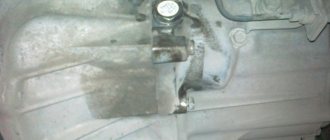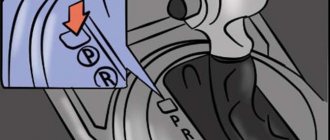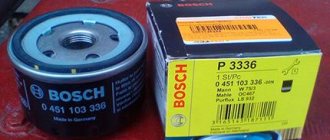No matter how reliable the unit is, it is still necessary to carry out routine maintenance work in a timely manner to extend its service life. This applies to all components and assemblies of the car, including the transmission. In this article we will look at the issue of maintenance and oil change in the gearbox (both in automatic and manual transmissions of a car).
We will also try to determine what time intervals should be between routine transmission maintenance work, or at what mileage this work should be carried out. At the same time, we will consider which transmission oils are best to use, and we will also pay attention to the nuances and features that need to be known and taken into account when performing transmission maintenance work.
How long does it take to change the gearbox oil?
Routine maintenance work on a car transmission includes changing the oil (manual transmission) or transmission fluid with replacing the gasket and filter (automatic transmission).
The first oil or transmission fluid change is specified in the vehicle's operating instructions. But there are also cars in which manufacturers do not regulate further oil changes in the transmission.
In this case, replacement is carried out, as a rule, after the first 40-60 thousand kilometers, which depends on the type of gearbox. General recommendations for selecting and replacing lubricant for gearboxes include a list of general rules.
- For each transmission, a lubricating fluid strictly regulated by the manufacturer must be used (ATF for automatic transmissions and MTF for manual transmissions).
- It is necessary to avoid mixing oils or transmission fluids from different manufacturers during partial replacement or when topping up.
- When the vehicle transmission is used intensively, the service interval for replacing the lubricant must be reduced.
- Before you start changing the oil or transmission fluid, you need to determine the type of fluids and lubricants used.
Manufacturers' recommendations
Many companies that produce automatic transmissions do not recommend changing the lubricant. Manufacturers argue that this is due to unnecessary costs. Since the transmission fluid filled in at the factory, according to manufacturers, can not be changed until the service life of the automatic transmission expires. For example, like on a Mercedes Benz with a five-speed automatic transmission. Other companies write that the frequency of oil changes depends on the environment in which the car is operated.
Experienced car owners believe that it is worth changing the oil in the automatic transmission after driving sixty thousand kilometers.
The following table from automatic transmission manufacturers shows the frequency of oil changes for different operating environment conditions of the vehicle:
| terms of Use | Mileage | Year of manufacture of the car |
| Difficult, in the north, in countries with hot summers and frosty winters, cities with a damp climate, cold and abrupt starts (territory of the Russian Federation) | 40 000 – 60 000 | Until 2000 |
| Similar to the first (territory of the Russian Federation) | 80 000 | After 2000 |
| Moderate climate, smooth roads, driving in a metropolis, country roads, without cold and sudden starts, careful driving | From 50,000 to 80,000 | Until 2000 |
| Similar to the previous one | 120 000* | After 2000 |
Read
Do-it-yourself oil change in a Nissan Juke automatic transmission
*For example, the same Mercedes Benz manufacturers recommend changing the oil after 125,000 kilometers for vehicles manufactured by the company after 2000.
Types of oils or fluids (types of gearbox lubricants)
- Mineral is the most popular lubricant for low-speed gearboxes. A cheap type of liquid that quickly loses its properties. It is recommended to change this fluid every 30-40 thousand km. mileage
- Semi-synthetic type - suitable for high-speed gearboxes. The lubricating fluid from this group is saturated with additives to improve chemical properties and anti-corrosion properties. The recommended replacement interval is 40-50 thousand km. mileage
- Synthetic type is the most expensive type of lubricant with a large number of high-quality additives. Mainly used in automatic transmissions. The recommended replacement interval for “synthetics” for manual transmission is 60-80 thousand km. mileage, for automatic transmission up to 50-60 thousand km.
Regulations and compliance
The automaker's recommended transmission oil change intervals for all components (not just manual transmissions) are usually specified in the “Maintenance” or “Transmission” sections of the operating instructions. The key word here is “recommended”. Because each car is used in different conditions. And the rate of oil aging, the rate of wear of gearbox parts, as well as the initial quality of gear lubricant are individual factors in each individual case.
Should the oil in a manual transmission be changed according to the car manufacturer's instructions or are there other standards? If the following conditions are met, a planned replacement is sufficient.
- The vehicle is operated under normal conditions. This concept means a mixed driving cycle (approximately the same mileage on the highway and in the city) without intense and prolonged overloads, such as driving close to maximum speed or systematically towing loaded trailers.
- No leakage through the pan gasket (if there is one), axle shaft seals (cardan flange) or input shaft.
- Normal operation of the gearbox, easy shifting of the lever, no hum or other extraneous noise.
If all three conditions are met, then the oil must be changed according to the car manufacturer's instructions. Replacement intervals usually range from 120 to 250 thousand km, depending on the car model and the oil used. In some manual transmissions, oil is filled for the entire service life.
How long does it take to change the oil in an automatic transmission and how to change the oil
The procedure for replacing transmission fluid in automatic transmissions is individual for each model. You can find it out either on the official website of the manufacturer or get information from the car manual. Most often, the interval is 40-50 thousand kilometers.
There are two options for replacing transmission fluid:
- Partial ATF replacement is performed during routine maintenance of the vehicle transmission. The transmission fluid from the automatic transmission is not completely drained (no more than half of the used fluid), since some of the fluid remains in the automatic transmission.
- A complete ATF replacement is not performed very often. As a rule, after purchasing a car with high mileage, or in case of problems when shifting gears (diagnosed as “floating” malfunctions of the solenoid unit).
The complete replacement procedure includes washing the automatic transmission with special flushing compounds. This method is quite expensive and labor-intensive, requiring a special installation (provides accurate dosage of ATF, automatically takes into account the volume of drained transmission fluid to calculate the replacement volume).
Let us add that the selection of transmission fluid for an automatic transmission is an important procedure. In the vehicle service book, the manufacturer indicates the type of transmission fluid. Automatic transmissions of various types (hydromechanical automatic transmissions, CVTs, robotic gearboxes) require a fluid whose properties will be optimized for a specific type of transmission.
Typically, automatic transmission manufacturers use their own ATF transmission fluid standards (Dexron, Mercon, etc.). To correctly select transmission oil for your car, you need to know the car make, model and modification. Let us remind you once again that the automatic transmission uses synthetic transmission fluid.
How to change the oil in a manual transmission
It is recommended to change the oil in the gearbox in autumn or winter. It is during this period that the unit bears the heaviest load and the probability of its failure is high. An urgent oil change is also required for newly purchased used cars with a mileage of over 60,000 km. The independent procedure for replacing the working fluid in the gearbox consists of several stages.
- We warm up the oil by driving for ten minutes. Placing the car on a specially equipped pit with the wheels secured using “shoes”;
- Unscrew the oil filler plug;
- Remove the drain plug and drain the oil into a container;
- We fill the unit with new oil using a syringe to the lower limit of the “oil filler” neck (be careful not to overfill), tighten the cap (most often you need a new set of cap and o-ring).
If you are not confident in your own abilities, seek help from professional mechanics.
Official service centers of FAVORIT MOTORS Group offer a wide range of services for maintenance, diagnostics and repair of cars of any make and configuration. Do not neglect problems with the gearbox, other components and assemblies of the machine, your safety depends on their condition! Transmission oil catalog Ask a question
Manual transmission: after how many thousand to change the oil in the box
Most often, changing the oil in a manual transmission is not provided for by the car manufacturer itself, that is, technical recommendations do not contain direct instructions. However, this does not mean that the oil in the mechanic’s box does not need to be changed, since malfunctions and accelerated wear of the unit are associated precisely with the fact that the lubricating fluid loses its properties over time and becomes contaminated with wear products.
For this reason, in order to avoid premature failure of the manual transmission, experts recommend changing the oil every 50-60 thousand km. mileage If the unit operates under constant overload, the oil change interval is reduced by almost a third or more.
We also recommend reading the article on how to change the oil in an automatic transmission. From this article you will learn about the procedure for replacing ATF fluid in an automatic transmission, as well as what needs to be taken into account as part of this procedure.
It is recommended to completely change the oil in the manual transmission. If you have an inspection hole or overpass, the necessary tools and a container for draining used oil, you can carry out the replacement yourself.
Basic recommendations for changing oil in manual transmissions:
- Before changing the oil, the box must be warmed up (heated oil is better removed when drained);
- after completely draining the used oil, before tightening the drain hole, it is necessary to replace the sealing ring on the drain plug in the box housing with a new one;
- new oil is poured into the filler hole using a syringe;
- the oil level should be at the lower edge;
The selection of lubricant for manual transmissions also needs to be done with great care. There are three main types of manual transmission oil described above: mineral, synthetic and semi-synthetic.
The type of lubricant base on the packaging is indicated by the API marking. It has five classification groups: from 1 to 5. They are also designated by the letters GL. Also, transmission oils for manual transmissions differ in the temperature range at which their use is permissible. On the label the group is indicated by numbers next to the letter W.
When selecting oil for a manual transmission, it is necessary to take into account the type of oil base, viscosity and temperature indicators. Information on the car will help you choose the right oil for mechanics: year of manufacture and model, manufacturer’s recommendations. Typically, manual transmissions use semi-synthetic and synthetic oils. Older types of boxes used mineral-based oils.
Cases when the oil should be changed regardless of mileage
There are practically no ideal operating conditions for a car. There are always some deviations from the standards prescribed by the manufacturer. For example, a long trip at maximum speed due to a rush, or a long towing of another, often heavy car. All this affects the service life of the transmission oil.
Let's consider several common situations and characteristic symptoms in which it is necessary to change the transmission oil in a manual transmission ahead of schedule, before the scheduled mileage.
- Buying a used car with high mileage. If you don’t know the previous owner well and there is a possibility that he did not change the oil on time, we drain the waste from the manual transmission and fill it with fresh lubricant. The procedure is relatively inexpensive, but it will ensure that the box is serviced.
- Leaks through seals. Constantly adding oil in this case is not the best option. Ideally, the seals will need to be replaced. But if this is not possible, change the oil no later than the regulations require. Better yet, more often. Leakage through the seals does not usually mean that wear debris is washed out of the box. And if you limit yourself to one topping up, small chips and heavy oily fractions, oxide products, which will later develop into sludge deposits, will accumulate in the box. Also pay special attention to the condition of the lubricant after driving through deep puddles and in wet weather. There are known cases when, after such a ride, water leaked into the box through the same leaky seals. And driving on lubricant enriched with water will lead to corrosion of manual transmission parts and accelerated wear of gears and bearings.
- Stiff lever shifting. A common cause is aging of the lubricant. This phenomenon is often observed on domestic cars closer to the replacement date. Has the lever become more stubborn? Don't rush to sound the alarm. Just change the oil first. In more than half of the cases, after updating the transmission lubrication, the problem of a tight lever either goes away completely or is partially leveled.
- Cheaper and lower quality oil was poured. Here, too, reduce the mileage between replacements by 30-50%.
- The car drives in dusty conditions or at extreme temperatures. Under such conditions, oil life is reduced. Therefore, it is advisable to change it 2 times more often.
- Any repair of the box with oil drain. In this case, saving on oil is irrational. In addition, you will save yourself from the need for a separate replacement for a long time.
In other cases, adhere to the regulatory deadlines.
Changing the automatic transmission oil: why, when and in what cases is it too late?
The oil in any automatic transmission performs many functions at once. It works as a lubricant for bearings, removes heat from heating parts, and serves as a working fluid for the torque converter and for the hydraulic control system. In order for all parts of the box to work as they should, the oil must maintain its properties within a fairly small range of values. A slight deviation of the parameters beyond the permissible limits - and now one of the parts of the automatic transmission is not working correctly. And this affects the behavior of the car: jerks appear, loss of traction, and finally, the car simply stops moving. What happens to the oil and the box?
How does oil work in an automatic transmission?
Perhaps a little introduction to the design of modern automatic transmissions would be helpful. And if you have spent the last 30-40 years in a lethargic sleep or on a desert island, let me tell you the situation: almost all gearboxes have evolved from systems with purely hydraulic control to electronically controlled ones.
Initially, a hydrodynamic transformer, also known as a gas turbine engine, worked in conjunction with a planetary gearbox, in which shifts were performed by applying pressure to one or another group of clutches or a brake band using pneumohydraulic dispensers. This global principle remains.
Sometimes the gearboxes still have a gas turbine engine, sometimes it is replaced by a set of clutches, sometimes the gearboxes are made in the form of classic planetary ones, but there are also shaft structures (mainly in Honda), as well as chain and belt drives of variators.
Articles / Practice “Donut”, automatic transmission killer: what breaks in torque converters and how they are repaired The torque converter, also known as the “donut” (the nickname comes from its shape), is an indispensable attribute of any “real automatic”. Powerful CVTs cannot do without it, and even in preselective ones... 176851 5 33 03/19/2015
But with rare exceptions, the control system still supplies pressure to the actuator units, the pressure is created by the oil pump, and the oil still lubricates, cools and directly controls gear shifts.
The ones that have moved away most from the “classical” scheme are the simplest “robots” with one clutch and Getrag 6DCT250 gearboxes - in these automatic transmissions, oil is used only to lubricate and cool the gearboxes, the clutches are air-cooled, and the control system is electrically driven. All other automatic transmissions suffer to one degree or another from the need to combine a bunch of different functions with oil.
And oil can perform these functions only if it has a strictly defined viscosity and lubricating properties. At this point, you probably guessed that oil cannot retain these qualities forever.
How does the oil in the box wear out?
Any ATF (automatic transmission fluid, i.e. automatic transmission fluid) begins to lose its characteristics over time. First of all, from overheating due to hard driving in combination with a dirty radiator, as well as from microparticles getting into the oil from the friction clutches and blocking linings of the gas turbine engine. Therefore, the actions of the masters who take a sample of oil to assess whether it smells burnt and whether it has retained its transparency are not without logic.
But even if the oil is absolutely clean and not overheated, it still loses its properties with age. Extreme pressure and viscosity-setting additives are produced, and the base also loses its properties. In actual operation, all these troubles are supplemented by contamination of the oil with products of its own decomposition, as well as wear products of the box. In addition to the already mentioned friction clutches and gas turbine linings, these also include particles of worn bearings and gearboxes.
By the way, pay attention to the material of the clutches; it is not for nothing that relatively soft cardboard was chosen for it, rather than more reliable ceramics, because the wear products of cardboard do not harm the automatic transmission so much. However, in advanced cases and without any ceramics, particles of ash, metal and cardboard gnaw out entire cavities in the aluminum of hydraulic plates and gearbox valves. You can imagine what will happen if the clutches are made of carbon or ceramics.
In general, it is already clear that the oil ages and loses its properties, and therefore needs to be replaced. But for some reason this is not obvious to everyone.
Where did the opinion come from that the automatic transmission oil does not need to be changed?
To maintain oil characteristics at approximately the same level, literally twenty years ago all automakers recommended changing automatic transmission oil at intervals of 30-60 thousand kilometers. But progress did not stand still, electronic transmission control systems appeared, and the adaptability of the transmission to driving conditions and the characteristics of the working fluid increased many times over.
Articles / Practice “Mechanics” also break down: anti-rating of manual transmissions Everyone has heard that repairing an “automatic” is an expensive pleasure, and there are many questions about their reliability. Mechanical boxes are considered almost the standard of reliability. Meanwhile, there is something... 220222 32 33 11/10/2014
And then the most “advanced” manufacturers announced for the first time that from now on there was no need to change the oil anymore. I’m not afraid to point my finger, this is primarily the venerable Mercedes-Benz and its competitors in the “German Big Three”, Audi and BMW. Moreover, Mercedes allowed a similar interval for its revolutionary five-speed automatic transmission of the 722.6 series, but competitors did not have their own transmissions, and the beautiful inscription “oil filled for the entire service life” initially appeared in the data sheets of only cars equipped with transmissions manufactured by ZF. However, both Mercedes and BMW still stipulated in fine print an oil change under severe operating conditions.
The automotive industry focuses on leaders, and such an extravagant step did not go unnoticed: over time, almost all car manufacturers have greatly increased the time frame for changing transmission oils. What this led to can be seen by comparing the reliability of automatic transmissions in the early and late nineties of the 20th century. Practice has convincingly proven that it is necessary to change the oil, and according to the regulations, in advance.
And now even the big German three have the oil change interval specified in the car’s passport. For example, for MBs of the last five years of production in the same automatic transmissions of the 722.6 series with which the “eternal” oil began, a single oil change is recommended at 50 thousand kilometers or after three years, and for the newer seven-speed 722.9 - every 125 thousand kilometers or every five years.
And in general, dealers of most brands recommend changing the oil every 60-80 thousand mileage, despite other instructions.
The problem is that with such a long replacement interval, the properties of fresh and old oil differ greatly. Even if the gearbox is in relatively good condition, this gives rise to many problems. And in the best case, it requires adaptation of the automatic transmission to the new working fluid, and in the worst case, it leads to inoperability and rapid failure.
We don't change
With a service interval of 60-80 thousand kilometers, it becomes difficult to comply with it. Firstly, the car can change its owner, and it is not clear from what mileage to count replacements. When selling, the mileage is often rolled up, you can hardly rely on your word, and service books are often “lost” or simply not kept very carefully after a year or two of operation. Why, even the dealers themselves simply forget about replacement. So it turns out that when buying a seemingly serviceable car with an automatic transmission, there is no certainty about how long the oil has been in the gearbox.
And I will repeat once again the thesis already expressed:
For some automatic transmission models, the standard replacement interval in our driving conditions and with our temperament is frankly too long.
Many car owners are cowardly looking for arguments in favor of the decision not to change the oil. This makes some sense. A worn-out box often works quite well on oil with friction crumbs and an unknown viscosity, but when replacing the oil with fresh, more slippery and with a full package of detergent and extreme pressure additives, the clutches no longer hold, the solenoids no longer hold pressure, and the detergent additives wash away all sludge into the thin channels of the valve body. At the same time, the full pressure of the oil pump blows out the gaskets, and now the car, which arrived for an oil change under its own power, is moved on a tow truck towards the “box” service.
Articles / Practice This scary CVT - myths and truth about continuously variable transmissions “Listen, isn’t it scary to take it with a CVT?” – those who are planning to buy a used Nissan Qashqai or, say, Audi A5 ask all the time. They are afraid of continuously variable transmissions... Fair enough... 07/09/2015
It’s a small matter, it’s quite easy to justify your fear: it’s enough to find the coveted “for the entire service life” in one of the versions of the user manuals, and now there is a desire and a reason not to change the oil consciously.
And here’s what’s surprising: the box can still drive for a very long time, and drive well. Meanwhile, the owner of the car presents this as an example of his dexterity and intelligence. After all, he didn’t pay for oil changes, adaptations, didn’t waste time, and everything is great, he’s great! Well, he will pass all the problems along with the car to the next owner, who will also face a difficult choice, but he will have less chance of a successful development of events.
If the standard oil change interval has long been missed, and the gearbox has been running on dirty ATF for 50-60 thousand kilometers, then its future fate is predetermined. If you change the oil, it will most likely fail. If you don't change it, it will work out too.
Many choose the second option: then all that remains is to pray to a higher divine power or, in the version for atheists, the theory of probability. Pray that the remaining life of the automatic transmission will last as long as possible. Preferably, long enough to have time to “leak” the car to the next owner.
We change
It’s great when the car’s maintenance history is known and written by competent craftsmen and the owner. The oil is changed regularly or even more often. It’s no secret that almost all modern automatic transmissions pollute it very much due to the active use of gas turbine engine blocking linings. And “preselectives” with wet clutches (for example, DSG DQ250 and DQ500) even operate the clutch in an oil bath. At the same time, wear products of the linings enter the oil in a very large volume, and due to the design features of the boxes and low operating pressure, the filters cannot completely retain all foreign particles.
So let's define it again:
The automatic transmission oil needs to be changed, and as often as possible. Changing it ahead of schedule - after 30-40 thousand kilometers - is a great idea.
But oddly enough, this is a rather rare case. But practice shows that when a car is in the same hands and is maintained carefully, at least according to the specifications laid down for “difficult road or climatic conditions,” even fragile modern units of such cars show miracles of survivability. Alas, much more often in a series of owners there is one thrifty, overly cunning or simply greedy and hasty.
How to change the oil in an automatic transmission - by displacement, partial replacement, etc.
The good thing about electronic control of the automatic transmission is that the box can be diagnosed without removing it. Not always, but with the help of a dealer scanner with specialized software you can determine the health of the box by simply connecting to the control unit. So, if the automatic transmission feels good, there are no errors, no jerking, no slipping, then you can try to return it to the full maintenance interval.
The best, but also the most risky way is to completely change the oil by pumping or displacing. In this case, all old oil with wear products is replaced with fresh and clean oil, after which the adaptations are reset using the same dealer scanner.
Contrary to popular belief, the oil displacement method almost always works perfectly if the gearbox was working well before the replacement.
Then after replacement it will work no worse. Exceptions are rare, and mainly concern cases where the presence of problems was nevertheless ignored.
Very often they try to change the oil when problems have already appeared, and there is no point in acting head-on. If the automatic transmission has demonstrated some kind of “first call”, the method of action changes. A good technician will dissuade you from a complete replacement and will suggest a partial fluid change - in this case, only part of the oil is simply drained, without connecting the pump. Wear products are “diluted”, and after a short mileage the operation is repeated.
Articles / Practice If you don’t know how, don’t lie: how to change engine oil correctly I bet you cut off a finger (someone else’s, just not your own), which many will now grin sarcastically: what can be said new about this standard procedure for any maintenance? Laugh-… 02/12/2016
This method avoids two problems. Firstly, a sharp change in the characteristics of the oil, due to which the operating conditions of the gearbox components will greatly change and the arrival of a large amount of detergent additives, which, as we have already found out, can cause clogging of the hydraulics. At the same time, you can do without a dealer scanner and special equipment for changing the oil, which makes this method preferable for small services. By the way, if you pay attention, the story about the inadmissibility of changing oil by forcing it out is primarily the small service stations and their adherents. This makes it easy to understand that another “religious” view of car repair has a very solid economic basis.
In the interval between oil changes, the impact of work on the behavior of the unit is usually assessed, and if there is positive dynamics, then changes are continued. Sometimes at the end of changing the oil it is already displacement. If the changes are negative, then you just need to wait.
The method is undoubtedly safer from the point of view of the consequences of replacement, but is slightly reminiscent of cutting off the tail in parts, moreover, the oil in this way inevitably retains a significant part of the contaminants, despite the restoration of other characteristics.
To summarize:
The partial replacement method is suitable only for cases of “average neglect”. If the regulations are met, change the oil by displacement.
In cases where the condition of the old oil in the box indicates serious wear of the structure, and its behavior no longer indicates the “first”, but rather the “tenth” call, then it is worth using another method. If the owner wants to change the oil and not immediately invest in an automatic transmission overhaul, it usually makes sense to combine the oil change with cleaning and testing the valve body, as well as replacing the gaskets.
In fact, this is no longer an oil change, but a gearbox repair, but the main factor in “recovery” in this case will be the replacement of the working fluid, with the elimination of the negative factors of the replacement. The method is practiced mainly on longitudinally located units with a lower location of the valve body, on which the automatic transmission housing and the valve body itself can be easily removed, which ensures a relatively low cost of such an operation. Sometimes after such actions of replacement and cleaning, the condition of the “machine” returns to normal, but, to be honest, the chances are slim. Much more often the result will be either a minimal improvement in the situation or... complete failure of the box.
What's the result?
The oil needs to be changed. Until they come up with a way to bypass the aging of technical fluids and wear of the mechanical part of the automatic transmission, this operation is inevitable. The environmental lobby and marketers are not on your side; they have little interest in the long-term operation of the car. As, indeed, are many other people.
You should not believe in fairy tales about miraculous fluids that preserve automatic transmissions for years - magic is not yet available, and the aging period depends only on the operating temperature, volume and operating conditions.
Change the oil without fanaticism, but the more active you drive, the more often you get stuck in traffic jams and the hotter your engine, the more often. Not necessarily entirely, it can be partially, but at intervals of half or even a third from those recommended by the factory. The main thing is not to do this when your automatic transmission is already half dead and changing the oil turns from prevention into shamanism.
Survey
Do you change the oil in the automatic transmission?
Your voice
Total votes:
Why you need to service your transmission
Motor oil most often operates at the optimal temperatures for which it is designed - simply because the engine is heated by internal combustion and has more efficient cooling. In a gearbox, heating occurs only from friction forces, and it overheats much more often. In hot weather and during intensive use, the temperature in the transmission can exceed the engine temperature by 15-20 degrees Celsius. And overheating accelerates oil degradation.
The individual components of the transmission wear due to friction against each other. Chips get caught in the oil, and the only way to remove them before they start clogging the fine grooves is to change the oil. In gearboxes, these shavings are mainly steel; in manual gearboxes, particles of worn synchronizers - brass, bronze and various composites - are added to this. In the case of automatic transmissions and CVTs, there is also waste from friction discs. Let's not forget about the dust that gets into the valves during the overheating/cooling cycle. When digging deep puddles, water can also get inside.
Today's "downsized" turbocharged engines make things worse because they produce more torque and put more stress on the transmission. It seems obvious that a little attention is needed to cope. But how much attention? Here manufacturers cannot give clear answers.
The Russian magazine "Behind the Wheel" recently asked several large manufacturers for recommendations and received different answers even for brands of the same concern (and with the same units in them). There are probably many reasons, including the fact that each brand has its own after-sales service policy. Anyway, here are the recommendations for different brands.
Difficult conditions
Previously, there was talk about the time interval for changing the oil in an automatic transmission, which can differ significantly if the machine often operates under overload. For example, when a vehicle is used to tow other equipment or a trailer, it is constantly used to transport various cargoes. Long trips on off-road and dirt roads have a negative effect on operational parameters.
Also, the fluid in the automatic transmission requires quick replacement if you drive the car in extreme heat or cold. Traffic jams also significantly reduce the time interval between oil changes. You need to calculate how much you will have to pay for not maintaining your gearbox. With dirty oil, every ten kilometers will cause a lot of wear on parts.
Statistics information
Whatever interval the manufacturer sets, after some time it is necessary to visit the workshop and monitor the quality of the oil in the box. The oil in the box must be filled only with that recommended by the factory, and not mixed with fluids from other companies. There is no need to change the oil very often, as this will not affect the functioning of this device.
If the car has been used in difficult conditions, it is recommended to change the oil in the automatic transmission after 30 thousand km, if the car was manufactured before 2000. It should not be confused that in a manual transmission the replacement process must be carried out more often. New cars are usually capable of driving up to 80 thousand km without changing the automatic transmission oil, but in practice this value can be much greater, it all depends on driving style.
If the car was driven in moderate mode, then you only need to monitor the oil level after several thousand km. If the engine overheats frequently, the oil in the box may reduce its performance parameters. We must not forget that many drivers in our country operate their cars in difficult conditions, so it is better to change the oil after a shorter period of time.
After a certain time, all drivers approach the issue of changing the oil in an automatic transmission, but you need to figure out how not to buy fake oil, and what brand to buy. The service life of the oil depends on its properties, which should not be forgotten when purchasing.
First of all, you need to pay attention to the popularity of the brand of oil, but the most common ones are often famous for being fake. You can find out about the cost of oil from the seller.
Professionals recommend using original high-quality oils, since using low-quality counterfeits will significantly reduce the service life of the oil.
What are we lubricating?
In a front-wheel drive car, only the gearbox needs lubrication. Transmission oil is poured into the mechanical one, and fluids are poured into the automatic, variator or robot, which not only lubricate the parts, but also participate in the transmission of torque and drive the actuators.
In a rear-wheel drive car, a rear axle with a hypoid pair is added to the gearbox. Well, most of the units and components in which oil must be filled are in all-wheel drive transmissions: angular gearboxes, transfer cases, couplings for connecting axles or torque distribution.











